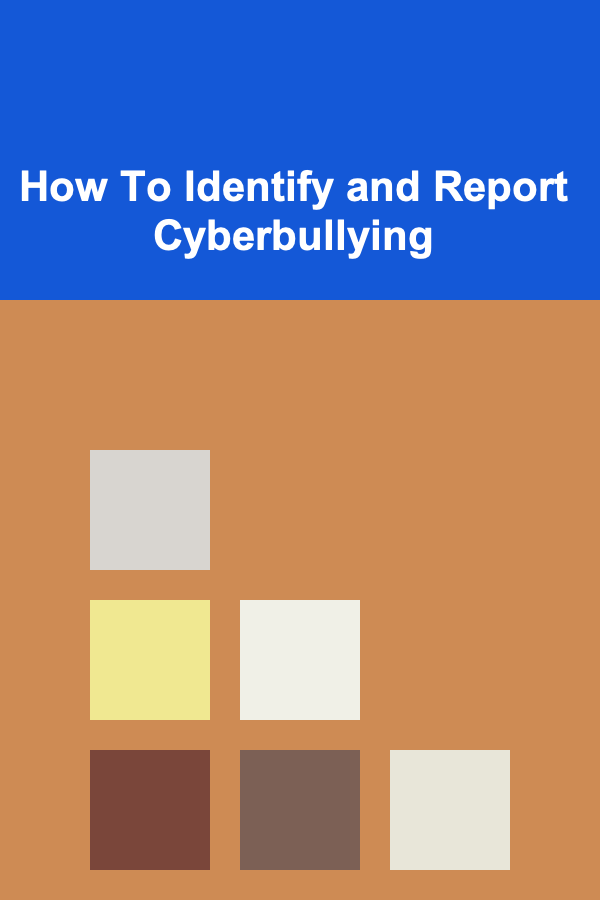
How To Identify and Report Cyberbullying
ebook include PDF & Audio bundle (Micro Guide)
$12.99$7.99
Limited Time Offer! Order within the next:

Cyberbullying is a rapidly growing issue in the digital age, affecting people of all ages and backgrounds. With the increasing use of social media, gaming platforms, and messaging apps, the internet has become a place where people can connect, share, and communicate. However, it has also become a breeding ground for harmful behaviors such as cyberbullying.
Cyberbullying is the use of digital technology to harass, intimidate, or harm others. It can take various forms, such as sending mean or threatening messages, spreading rumors, posting embarrassing photos or videos, and impersonating someone online. As the internet becomes more integrated into our daily lives, understanding how to identify and report cyberbullying has become more important than ever.
This article will delve into the nature of cyberbullying, how to recognize its signs, and how individuals, parents, and educators can take steps to report it effectively. By doing so, we can work together to create safer online spaces for everyone.
What Is Cyberbullying?
Cyberbullying can be defined as the deliberate use of electronic communication to harass, threaten, or manipulate others. Unlike traditional bullying, which often takes place in person, cyberbullying occurs in online spaces, which can be accessible 24/7. This makes it more pervasive and harder for the victims to escape.
There are several forms of cyberbullying, including:
- Harassment: Sending offensive or threatening messages repeatedly to someone, causing distress.
- Impersonation: Pretending to be someone else online, often with the intention of spreading lies or causing harm to that person.
- Outing: Sharing personal information, photos, or videos of someone without their consent to embarrass them.
- Exclusion: Intentionally excluding someone from online groups, chats, or social events, making them feel isolated.
- Doxxing: Publishing private or sensitive information about someone on the internet to cause harm or shame.
Cyberbullying can take place on social media platforms, text messaging, emails, online gaming environments, and even through public forums or comment sections. Due to the anonymity that the internet offers, cyberbullies can act without immediate consequences, making their behavior even more damaging.
Signs of Cyberbullying
Recognizing cyberbullying is the first step toward addressing it. The signs may not always be obvious, but there are certain red flags that can indicate a person is being targeted.
Behavioral Changes
One of the most noticeable signs of cyberbullying is a sudden change in behavior. Victims may become more withdrawn, anxious, or depressed. They may avoid going online or participating in social media activities, which they previously enjoyed. If someone close to you begins to display signs of distress, irritability, or a lack of interest in their usual hobbies, this could be a sign that they are experiencing cyberbullying.
Decline in Academic Performance
Cyberbullying can have a significant impact on a person's mental health and overall well-being. Victims may struggle to concentrate in school or at work due to the stress caused by online harassment. This can lead to a noticeable decline in academic or work performance, as well as a lack of motivation to attend school or participate in group activities.
Physical Symptoms
The emotional toll of cyberbullying can also manifest in physical symptoms. Victims may experience sleep disturbances, headaches, stomachaches, or other physical signs of stress. These symptoms often go unnoticed by others, but they are important indicators of the emotional distress caused by online harassment.
Social Withdrawal
Cyberbullying can cause individuals to isolate themselves from friends, family, and online communities. They may stop participating in social activities or decline invitations to events, as they feel unsafe or uncomfortable in those environments. The feeling of isolation can further exacerbate feelings of loneliness and depression.
Sudden Changes in Online Behavior
If someone suddenly changes their online behavior---such as deleting social media accounts, blocking or unfriending people, or hiding their digital presence---it may indicate that they are trying to protect themselves from cyberbullying. These actions are often an attempt to avoid the harassment or escape the toxic online environment.
How to Identify Cyberbullying
Recognizing the signs of cyberbullying can help you intervene and provide support to the victim. However, identifying cyberbullying can sometimes be challenging because the behavior is often subtle or hidden. Here are some practical tips to help you identify cyberbullying:
Monitor Social Media and Online Interactions
If you suspect someone is being cyberbullied, it can be helpful to monitor their social media accounts and online interactions (with their permission, of course). Pay attention to any negative or harmful comments, messages, or posts that may indicate bullying behavior. Look for signs of exclusion or deliberate attempts to embarrass or shame the person.
Look for Patterns of Harassment
Cyberbullying is often repetitive, with the same individual or group targeting the victim over time. Look for patterns in the messages or comments, such as the same people repeatedly sending harmful messages or spreading rumors. Cyberbullying tends to escalate over time, so it's important to intervene early to prevent further harm.
Ask Direct Questions
If you suspect that someone is being cyberbullied, one of the best ways to confirm it is by asking them directly. While this may be a sensitive subject, approaching the person with care and concern can help them feel safe enough to open up. Be supportive and nonjudgmental, and encourage them to talk about their experiences.
Check for Changes in Digital Footprint
Cyberbullies often target their victims by publicly shaming them or spreading their personal information. If you notice that a person's personal information, photos, or videos have been shared without their consent, this could be a sign that they are being bullied online. In some cases, cyberbullies may use fake profiles or anonymous accounts to spread rumors or harass others.
Reporting Cyberbullying
Once you have identified that cyberbullying is taking place, it is essential to take steps to report it. Reporting helps protect the victim and can lead to actions being taken against the perpetrator. Here are some steps to take when reporting cyberbullying:
1. Document the Incident
Before reporting cyberbullying, it's important to document the incident. Take screenshots, save messages, and record any relevant information that can help prove the harassment. This documentation can serve as evidence if you need to escalate the situation or take legal action.
2. Report the Behavior to the Platform
Most social media platforms, messaging apps, and online games have reporting tools that allow users to report abusive behavior. If the bullying is happening on a specific platform, such as Facebook, Twitter, or Instagram, report the harassment to the platform's moderation team. Include all relevant evidence, such as screenshots or links, to ensure that the platform can take appropriate action.
3. Contact the School or Employer
If the victim of cyberbullying is a student, report the issue to the school administration. Schools are legally obligated to address bullying and harassment, even when it occurs outside of school hours. Many schools have policies in place to deal with cyberbullying, and they can provide support to the victim.
For adults, reporting cyberbullying to the employer may be necessary, especially if the bullying is happening in a professional setting. Employers have a responsibility to ensure a safe work environment and can take steps to address the issue.
4. Report to Law Enforcement
In some cases, cyberbullying can escalate to criminal behavior, such as threats of violence or the distribution of explicit images. If the situation becomes threatening or involves illegal activity, contact law enforcement immediately. They can investigate the matter and take appropriate legal action against the perpetrator.
5. Seek Legal Advice
In more severe cases, it may be necessary to seek legal advice. Many countries have laws in place to protect individuals from cyberbullying and online harassment. A legal professional can help you understand your rights and guide you through the process of taking legal action.
6. Provide Support to the Victim
Throughout the reporting process, it's important to offer emotional support to the victim. Let them know that they are not alone and that there are people who care about them. Encourage them to reach out to friends, family, or a counselor for help during this difficult time.
Preventing Cyberbullying
While reporting cyberbullying is essential, prevention is equally important. Here are some ways to help prevent cyberbullying and create a safer online environment:
1. Educate About Online Etiquette
One of the most effective ways to prevent cyberbullying is through education. Teach individuals, especially children and teenagers, about the importance of online etiquette and responsible internet use. Encourage kindness, empathy, and respect when interacting with others online.
2. Set Privacy Settings
Encourage individuals to set strong privacy settings on their social media accounts and online profiles. By controlling who can view their content and who can contact them, users can reduce their exposure to potential cyberbullies.
3. Encourage Open Communication
Create an environment where individuals feel comfortable discussing their online experiences. Encourage open communication about any negative interactions or bullying that may occur. Being able to talk openly about these issues can help prevent them from escalating.
4. Monitor Online Activity
For parents and guardians, monitoring your child's online activity is crucial. Keep track of the platforms they use and the people they interact with. Set guidelines for safe internet use and regularly check in on their digital well-being.
5. Lead by Example
Finally, it's important to lead by example. If you're an adult or a mentor, model positive online behavior for younger individuals. Show them how to engage respectfully with others and how to report inappropriate behavior.
Conclusion
Cyberbullying is a serious issue that can have a long-lasting impact on victims. Identifying the signs of cyberbullying, reporting it promptly, and taking steps to prevent it can help create a safer online environment for everyone. Through education, awareness, and proactive measures, we can work together to combat cyberbullying and ensure that the internet remains a place for positive interaction and growth.
By fostering empathy, respect, and responsibility in the digital world, we can all contribute to ending cyberbullying and creating a healthier, safer online community.

How to Choose the Right Lip Balm with SPF
Read More
How to Improve Your Credit Score in 6 Months or Less
Read More
What Are the Best Organizing Methods for Small Spaces?
Read More
How to Recover from a Bad Date Gracefully
Read More
How To Use Anonymous Browsing Techniques
Read More
Exploring Blockchain for Charity and Philanthropy: A Deep Dive
Read MoreOther Products

How to Choose the Right Lip Balm with SPF
Read More
How to Improve Your Credit Score in 6 Months or Less
Read More
What Are the Best Organizing Methods for Small Spaces?
Read More
How to Recover from a Bad Date Gracefully
Read More
How To Use Anonymous Browsing Techniques
Read More